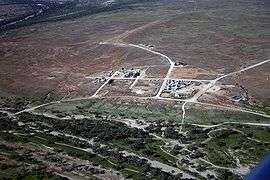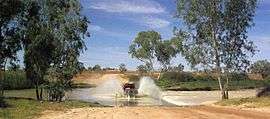Innamincka, South Australia
Innamincka, formerly Hopetoun, is a town and locality in north-east South Australia, with a population of 44 people.[2] It is 821 kilometres north-east of Adelaide and 365 kilometres north-east from the closest town, Lyndhurst.[1] It is also 66 kilometres north-east of the Moomba Gas Refinery. The town lies within the Innamincka Regional Reserve and is surrounded by the Strzlecki Desert to the south and the Sturt Stony Desert to the north. The township is situated along the Cooper Creek, a part of the Lake Eyre Basin.
| Innamincka South Australia | |||||||||||||||
|---|---|---|---|---|---|---|---|---|---|---|---|---|---|---|---|
 Innamincka from the north-east | |||||||||||||||
 Innamincka | |||||||||||||||
| Coordinates | 27°44′48″S 140°44′17″E[1] | ||||||||||||||
| Population | 44 (2016 census)[2][lower-alpha 1] | ||||||||||||||
| Established | 17 April 1890 (town) 23 October 2003 (locality)[4][5] | ||||||||||||||
| Postcode(s) | 5731 | ||||||||||||||
| Elevation | 57 m (187 ft) | ||||||||||||||
| Time zone | ACST (UTC+9:30) | ||||||||||||||
| • Summer (DST) | ACDT (UTC+10:30) | ||||||||||||||
| Location | 821 km (510 mi) NE of Adelaide | ||||||||||||||
| LGA(s) | Pastoral Unincorporated Area[1] | ||||||||||||||
| Region | Far North[1] | ||||||||||||||
| State electorate(s) | Stuart[6] | ||||||||||||||
| Federal Division(s) | Grey[7] | ||||||||||||||
| |||||||||||||||
| |||||||||||||||
| Footnotes | Adjoining localities[1] | ||||||||||||||


History
The area is the traditional home of the Yawarrawarrka and Yandruwandha peoples.
Wangkangurru (also known as Arabana/Wangkangurru, Wangganguru, Wanggangurru, Wongkangurru) is an Australian Aboriginal language spoken on Wangkangurru country. It is closely related to Arabana language of South Australia. The Wangkangurru language region was traditionally in the South Australian-Queensland border region taking in Birdsville and extending south towards Innamincka and Lake Eyre, including the local government areas of the Shire of Diamantina as well as the Outback Communities Authority of South Australia.[9]
Yawarrawarrka (also known as Yawarawarka, Yawarawarga, Yawarawarka, Jauraworka, Jawarawarka) is an Australian Aboriginal language of Far Western Queensland. The traditional language region includes the local government area of the Shire of Diamantina extending into the Outback Communities Authority of South Australia towards Innamincka.[10]
The first European to visit the area was Charles Sturt in 1845.[11] He was followed by A C Gregory in 1858 and then Burke and Wills. A monument to Sturt and Burke and Wills was erected in Innamincka in 1944.
In 1882 a police camp was set up that allowed a small settlement to develop.[11] Commencing 7 April 1889, a Royal Mail coach ran fortnightly from Farina, operated by merchants Davey and Pilkington.[12] Originally called Hopetoun, Innamincka was proclaimed as a town on 17 April 1890.[4] Hopetoun was named after the Governor of Victoria, the Earl of Hopetoun but it was never popular with locals[11] and was re-proclaimed as the Town of Innamincka on 28 January 1892.[13]
The town was never very large, but had a hotel, a store and a police station which, until Federation in 1901, acted as the customs post for collecting duties on cattle brought overland from Queensland into South Australia. In 1928 the Australian Inland Mission (a part of the Royal Flying Doctor Service of Australia) built a hospital here, the Elizabeth Symon Nursing Home. Severe drought and poor access to the settlement resulted in the closure of the hotel and the hospital. In 1951 the police post closed and the town was abandoned.
Increased tourism and discovery of gas and oil reserves in the late 1960s led to the formation of Cooper Creek Hotel Motel Pty Ltd, which opened a hotel, a store and accommodation in the abandoned town. In 1994 the Elizabeth Symon Nursing Home was restored by Dick Smith and Australian Geographic and was used as an interpretive centre for South Australian Parks and Wildlife. The nursing home had been listed on the South Australian Heritage Register on 25 July 1985.[14]
On 23 October 2003, boundaries were created for the locality of Innamincka which include the government town.[5] On 26 April 2013, the locality's boundaries were altered in order to include all of the Innamincka Regional Reserve and the Coongie Lakes National Park.[1]

Today the town has a population of about 15. The town common, on the banks of the Cooper, is popular with campers, as is the town's public coin-in-slot toilet and shower facility.
Gray's Tree, the supposed burial place of a member of the Burke and Wills expedition, is listed on the South Australian Heritage Register and located in the north-western rural area of the Innamincka locality.[15][16][17]
Burke and Wills
The Burke and Wills expedition passed through this area on their journey across Australia from Melbourne to the Gulf of Carpentaria. They established a Depot Camp on Cooper Creek at Camp LXV, (their sixty-fifth camp since leaving Melbourne), at a place now called The Dig Tree. There was a depot at the Dig Tree from 6 December 1860 to 21 April 1861.
The Victorian Contingent Party under Alfred Howitt was sent by the Victorian government to establish the fate of the expedition. Howitt found the remains of both leaders, Robert O'Hara Burke and William John Wills and buried them close to where the town is located today. He also found the sole survivor, John King living amongst and cared for by the Yawarrawarrka/Yandruwandha aboriginals, and returned him to Melbourne.
Howitt returned to the area in 1862 as leader of the Victorian Exploring Party. He established a depot camp at Cullyamurra Waterhole before exhuming the bodies of Burke and Wills and transporting them to Melbourne for a State Funeral.
Today it is possible to visit the locations of Wills' grave and King's site on Cooper Creek downstream of Innamincka, and Burke's grave, Howitt's camp and the Dig Tree on Cooper Creek upstream of Innamincka.
References
Notes
- For the 2016 census, the 'State Suburb of Innamincka' consisted of the government town of Innamincka and some adjoining land which is not part of the Innamincka Regional Reserve.[3]
Citations
- "Search results for 'Innamincka, LOCB' with the following datasets selected – 'NPW and Conservation Properties', 'Suburbs and Localities', 'Government Towns', 'Hundreds', 'Local Government Areas', 'South Australian Government Regions' and 'Gazetteer'". Location SA Map Viewer. Government of South Australian. Retrieved 14 April 2019.
- Australian Bureau of Statistics (27 June 2017). "Innamincka (State Suburb)". 2016 Census QuickStats. Retrieved 14 April 2019.

- "Search results for 'Innamincka, GTWN' with the following datasets selected – 'NPW and Conservation Properties', 'Government Towns' and 'Gazetteer'". Location SA Map Viewer. Government of South Australian. Retrieved 14 April 2019.
- Cockburn, John A. (17 April 1890). "Proclamation re the Town of Hopetoun" (PDF). The South Australian Government Gazette. Government of South Australia. pp. 1108–1109. Retrieved 14 April 2019.
- Weatherill, Jay (23 October 2003). "GEOGRAPHICAL NAMES ACT 1991 Notice to Assign Names and Boundaries to Places" (PDF). The South Australian Government Gazette. Government of South AustralIA. p. 3859. Retrieved 14 April 2019.
Assign the names YUNTA, BLINMAN, BOOKABIE, GLENDAMBO, YALATA, KINGOONYA, OLARY, INNAMINCKA, and MANNA HILL, to those areas Out of Councils and shown numbered 1 to 9 on Rack Plan 857 (Sheet 3)
- "Electoral district profiles - Stuart". Electoral Commission SA. Retrieved 18 July 2019.
- "Profile of the electoral division of Grey (SA)". Australian Electoral Commission. Retrieved 20 August 2015.
- "Monthly climate statistics: Summary statistics Moomba Airport (nearest weather station)". Commonwealth of Australia , Bureau of Meteorology. Archived from the original on 15 January 2019. Retrieved 14 April 2019.
-

-

- "Innamincka - South Australia - Australia - Travel". theage.com.au. The Age Company. 8 February 2004. Archived from the original on 31 December 2012. Retrieved 17 September 2009.
- Advertiser, 3 April 1889, p 7.
- Kingston, C.C. (28 January 1892). "Untitled proclamation re renaming of the Town of Hopetoun to the Town of Innaminck" (PDF). The South Australian Government Gazette. Government of South Australia. pp. 191–192. Retrieved 14 April 2019.
- "Regional Reserve Headquarters (former Australian Inland Mission [AIM] Elizabeth Symon Nursing Home), Innamincka Regional Reserve". South Australian Heritage Register. Department of Environment, Water and Natural Resources. Retrieved 13 February 2016.
- "Tree, possibly marking the burial site of Charles Gray, member of Burke & Wills' 1861 expedition', Lake Massacre, Innamincka Regional Reserve". South Australian Heritage Register. Department of Environment, Water and Natural Resources. Archived from the original on 5 March 2016. Retrieved 12 February 2016.
- "Stuarts Creek, 5720". Location SA Map Viewer. Government of South Australia. Archived from the original on 3 February 2016. Retrieved 16 February 2016.
- "Innamincka, 5731". Location SA Map Viewer. Government of South Australia. Archived from the original on 3 February 2016. Retrieved 16 February 2016.